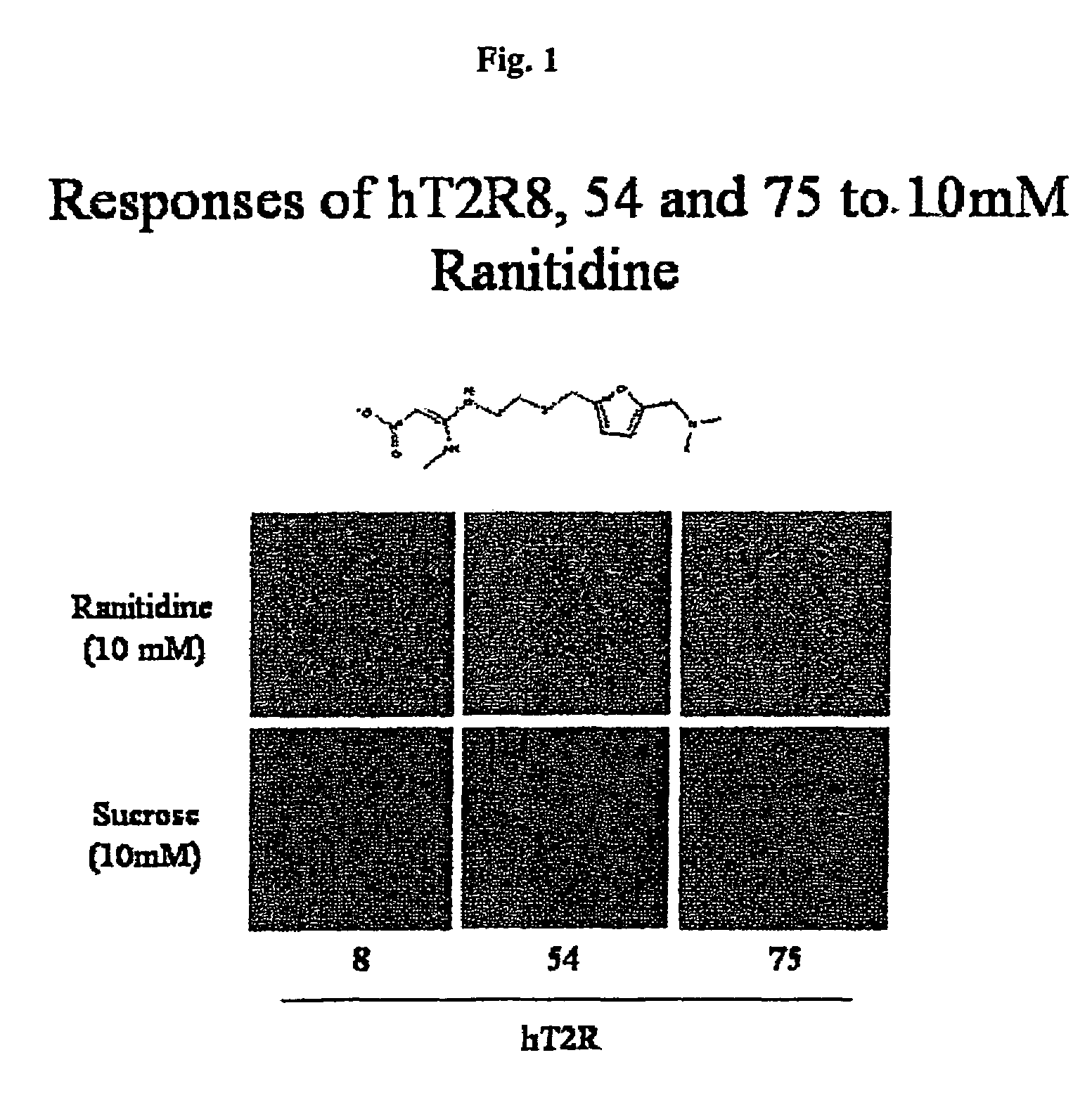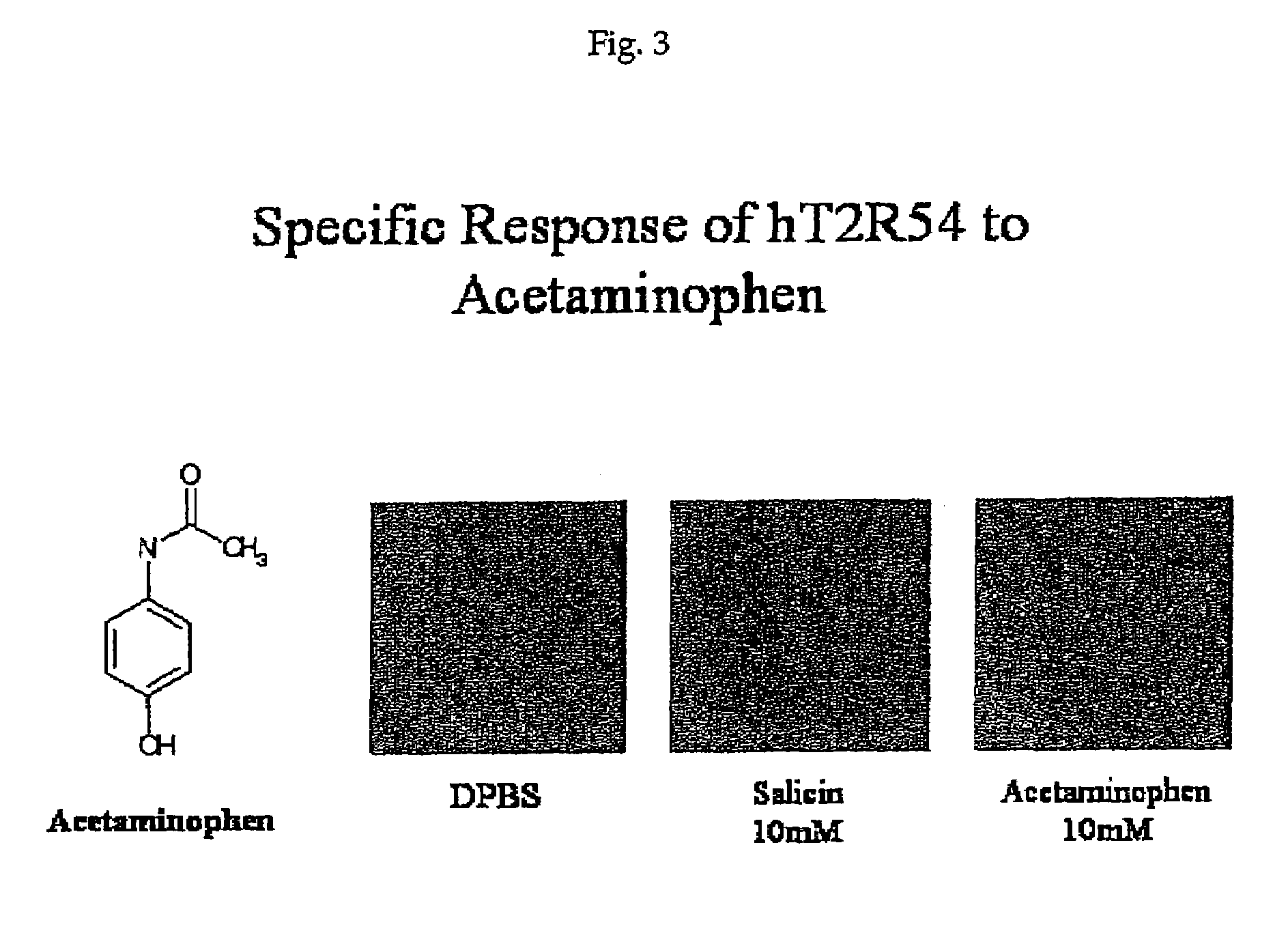Human T2R receptors for acetaminophen ranitidine, strychnine and denatomium and related assays for identifying human bitter taste modulators
a technology of acetaminophen and receptors, which is applied in the field of human t2r receptors for acetaminophen ranitidine, strychnine and denatomium and related assays for identifying human bitter taste modulators, can solve the problems of insufficient expression of receptors in cultured mammalian cell lines, inability to match chandrashekhar's specific bitter ligand to any ht2r, and inability to effectively
- Summary
- Abstract
- Description
- Claims
- Application Information
AI Technical Summary
Benefits of technology
Problems solved by technology
Method used
Image
Examples
example 1
[0183]In this example, we show that ranitidine, a bitter compound, specifically activates hT2R8, hT2R54, and hT2R75 human bitter receptors having the DNA sequence contained in this application.
[0184]Activation of these receptors by ranitidine is measured in a cell-based assay detecting changes in intracellular calcium concentration. In brief, human embryonic kidney cells stably expressing the large T-cell antigen and a chimeric G protein (G16gust44) are transiently transfected with the a plasmid containing a particular hT2R54 nucleic acid sequence either by Ca2+ phosphate or lipid-based systems. Transiently transfected cells are seeded into 24 well culture plates, and functional expression allowed to proceed for a total of 48 hours. The cells are then incubated with a fluorescent dye specific for calcium (Fluo-4 or Fura-2; Molecular Probes) that provides a fast, simple and reliable fluorescence-based method for detecting changes in calcium concentration inside the cell. Addition of ...
example 2
[0185]A HEK-G16gust44 line stably expressing high levels of hT2R8 or hT2R54 on its cell surface is used in high throughput screening assays. In this platform, the cells are seeded into 96 well or 384 well culture plates 18-24 hours before the assay. The cells are then incubated with the fluorescent calcium sensitive dye (Molecular Devices) and are stimulated and read in a standard fluorescence intensity plate reader (FLIPR or VIPR). Using this approach we have been able to further characterize the ranitidine effect on hT2R8 and hT2R54. We found that ranitidine activates hT2R8 and hT2R54 in a typical dose-response relationship (see FIG. 2).
example 3
[0186]In this example, we show that acetaminophen, a bitter compound, specifically activates hT2R54, a human bitter receptor having the DNA sequence contained in SEQ ID NO:10 in this application.
[0187]Activation of this receptor by acetaminophen is measured in a cell-based assay detecting changes in intracellular calcium concentration. In brief, human embryonic kidney cells stably expressing the large T-cell antigen and a chimeric G protein (G16gust44) are transiently transfected with the a plasmid containing the hT2R54 nucleic acid sequence either by Ca2+ phosphate or lipid-based systems. Transiently transfected cells are seeded into 24 well culture plates, and functional expression allowed to proceed for a total of 48 hours. The cells are then incubated with a fluorescent dye specific for calcium (Fluo-4 or Fura-2; Molecular Probes) that provides a fast, simple and reliable fluorescence-based method for detecting changes in calcium concentration inside the cell. Addition of raniti...
PUM
| Property | Measurement | Unit |
|---|---|---|
| Tm | aaaaa | aaaaa |
| temperature | aaaaa | aaaaa |
| temperature | aaaaa | aaaaa |
Abstract
Description
Claims
Application Information
 Login to View More
Login to View More - R&D
- Intellectual Property
- Life Sciences
- Materials
- Tech Scout
- Unparalleled Data Quality
- Higher Quality Content
- 60% Fewer Hallucinations
Browse by: Latest US Patents, China's latest patents, Technical Efficacy Thesaurus, Application Domain, Technology Topic, Popular Technical Reports.
© 2025 PatSnap. All rights reserved.Legal|Privacy policy|Modern Slavery Act Transparency Statement|Sitemap|About US| Contact US: help@patsnap.com



